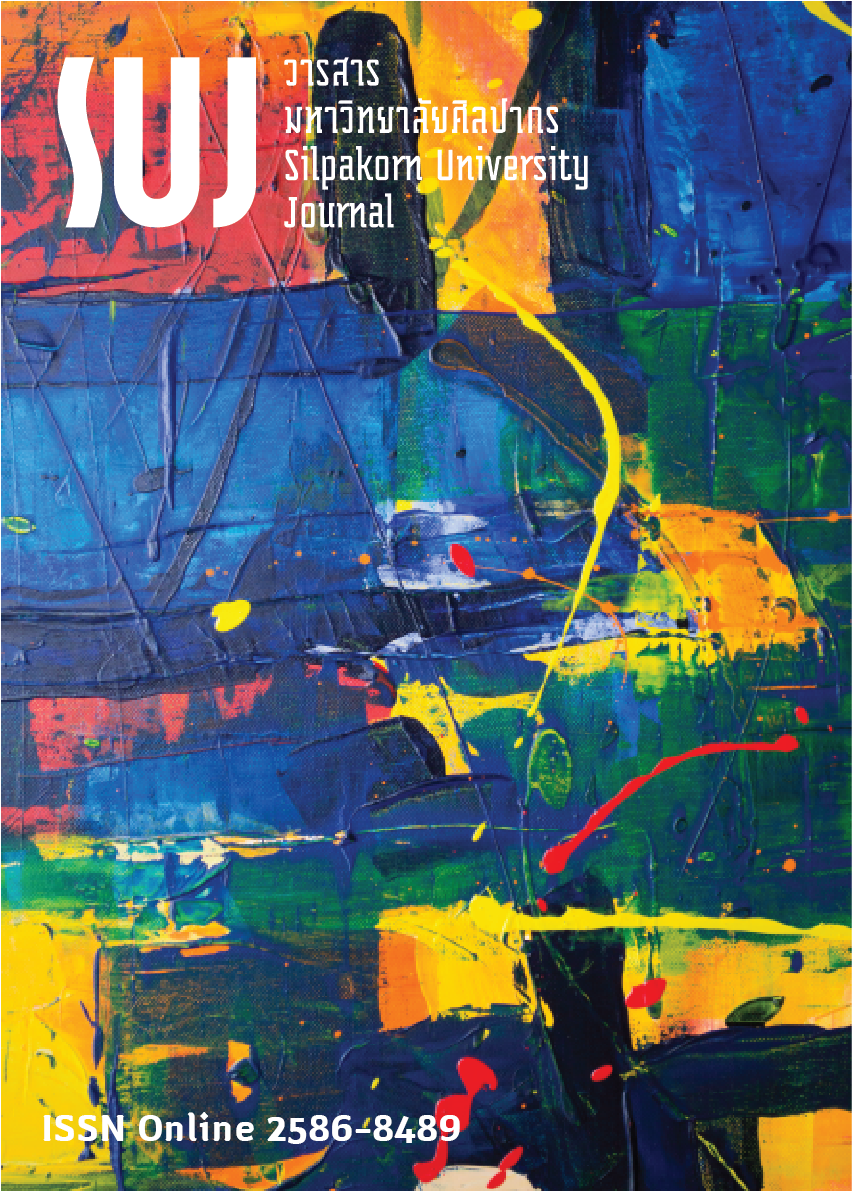การเดินทางของชีวิต : ความหมายต่อความชราภาพและการใช้ชีวิตของกลุ่มผู้สูงอายุไทดำ กรณีศึกษา ชุมชนไทดำในพื้นที่ตำบลดอนพุทราและตำบลบางปลา จังหวัดนครปฐม (The journey of life: Meaning of aging and living among Tai-Dam older ethnic group Case study Tai-Dam community of Donputcha and Bangpla Sub-district, Nakhon Pathom)
Main Article Content
Abstract
งานศึกษาวิจัยชิ้นนี้มีเป้าหมายในการศึกษาเกี่ยวกับประสบการณ์ชีวิต ความหมายและการปฏิบัติตัวของผู้สูงอายุไทดำ โดยใช้วิธีการศึกษาภาคสนามเชิงชาติพันธุ์วรรณนา การสังเกตการณ์แบบมีส่วนร่วมและการสัมภาษณ์เชิงลึกในชุมชนไทดำ 2 แห่งในจังหวัดนครปฐม ผู้ศึกษาใช้การสัมภาษณ์เชิงชาติพันธุ์วรรณนา ผู้สูงอายุไทดำ จำนวน 20 คน ในระยะเวลา 10 เดือน (พฤศจิกายน 2560 - สิงหาคม 2561) ผลการศึกษาสะท้อนให้เห็นว่า ความเชื่อเรื่องผีและวิญญาณบรรพบุรุษเป็นจุดศูนย์กลางทางอัตลักษณ์ของกลุ่มชาติพันธุ์ไทดำในกระบวนการเปลี่ยนผ่านของชีวิตภายใต้บทบาทของผู้อาวุโสและผู้มีความรู้ของชุมชน เรื่องราวของผู้สูงอายุไทดำในการดำรงชีวิตและการเดินทางไปสู่เส้นทางที่เป็นนิรันดร สะท้อนให้เห็นการต่อรองภายใต้เงื่อนไขของร่างกายทางธรรมชาติและทางวัฒนธรรมในการดำรงชีวิตและชีวิตหลังความตาย
This article is part of the research entitled “The Journey of Life: Meaning for Aging and The Life of the Tai Dam Aging Group in Nakhon Pathom Province”. The study applied ethnographic methods, including participatory observation, data collection, and indepth interviews with communities in the Tai Dam district, both men and women, totaling 20 people for a period of 10 months (November 2017-August 2018). The study found that the beliefs of ancestor ghosts and spirits remain the center of the ethnic identity of the Tai Dam people who have remained firmly in the transitional period under the role of the elderly who act as knowledgeable people. The story of the Tai Dam elderly concerning about living and traveling to the eternal path of life reflects the negotiation under the body’s natural and cultural conditions in living and afterlife.
Downloads
Article Details

This work is licensed under a Creative Commons Attribution-NonCommercial-NoDerivatives 4.0 International License.
References
Boukeaw, Phimphisut, & Teungfung, Ratiporn. (2016). Health Care and Health Status of Thai Aging (การดูแลสุขภาพและภาวะสุขภาพของผู้สูงอายุไทย). Journal of the Association of Researchers, 21(2): 94-109.
Cohen, L. (1998). No Aging in India: Alzheimer’s, The Bad Family, and Other Modern Things. Berkeley, California: University of California Press.
Duay, D. L., & Bryan, V. C. (2006). Senior Adults’ Perceptions of Successful Aging. Educational Gerontology, 32(6): 423-445.
Flatt, T. (2012). A New Definition of Aging? Frontiers in Genetics/Genetics of Aging, 3(3): 148.
Gheorghita, V. (2016). Anthropology and Population: Perspective on Aging. Revista de Stiinte Politice, 52: 71-83.
Hayami, Y. (1993). To be Karen and To be Cool: Community, Morality and Identity Among Sgaw Karen in Northern Thailand. Cahiers des Sciences Humaines, 29(4): 747-762.
Hawanon, Nawaporn, & Wattanotha, Theerawan. (2009). New Direction of Aging Residence Development in Thai society (ทิศทางใหม่ในการพัฒนาการอยู่อาศัยสำหรับผู้สูงอายุในสังคมไทย). Bangkok: Faculty of Architecture, Rajamangala University.
Maunchanchey, Renu. (2015). Social Functions of Belief of Thai-Song Ancestor Spirits in Korat Village, Nakhon Pathom Province (หน้าที่ทางสังคมของความเชื่อผีบรรพบุรุษไทโซ่ง บ้านเกาะแรต จังหวัดนครปฐม). Journal of Language and Culture, 34(1): 85-103.
McLeish, A. B. J. (1976). The Ulyssean Adult: Creativity in the Middle & Later Years. New York: McGraw-Hill Ryerson.
Othaganon, Pranom. (2001). The perfect of Thai Aging life: Principle of Research and Lesson of Experiences (ชีวิตที่สุขสมบูรณ์ของผู้สูงอายุไทย หลักการงานวิจัยและบทเรียนจากประสบการณ์). Bangkok: Chulalongkorn University Press.
Pitiphat, Sumitr, & Poonsuwan, Samerchai. (1997). Laos-Song: Dynamic of Cultural System in The Second Decade (ลาวโซ่งพลวัตของระบบวัฒนธรรมในรอบสองทศวรรษ). Bangkok: Thammasat University.
Potiwan, Piyaluk. (2015). Listening to Voices from Elderly : Fighting and Social Space Construction (เสียงจากผู้สูงอายุ : การต่อสู้และการสร้างพื้นที่ทางสังคม). Journal of Research for Development Social and Community, 2(13): 53-61.
Rose M. R. (1991). Evolutionary Biology of Aging. New York: Oxford University Press.
Rowe, J. W., & Kahn R. L. (1997). Successful Aging. Gerontologist, 37(4): 433-440.
Smuthkupt, Suriya, & Kittiarsa, Pattana. (2002). Why “Esan Man” Use Women Skirt Fabric Pack The Bai-Lan Scriptures (ทำไม “คนอีสาน” ในอดีตจึงใช้ผ้าซิ่นห่อคัมภีร์ใบลาน). Nakhon Ratchasima: Thaisuksanithat Room of Suranaree University of Technology.
Talarsky, L. (1998). Defining Aging and The Aged: Cultural and Social Constructions of Elders in the U.S. Arizona Anthropologist, 13(2): 101-107.
Watkhew, Mayuree. (1978). The Study of Tai-Dam Social structure (การศึกษาโครงสร้างสังคมของชาวโซ่ง). Master’s dissertation, Kasetsart University, Bangkok, Thailand.
Wongvipak, Chanun (1988). The Meeting Seminar Document in The Study Research of Ethnic Group in Western Region, Thailand (เอกสารประกอบการประชุมสัมมนาเรื่อง การศึกษาวิจัยกลุ่มชาติพันธุ์ในภูมิภาคตะวันตก). Nakhon Pathom: Faculty of Education, Silpakorn University.
World Health Organization. (2016). Ageing. [Online]. Retrieved October 3, 2016 from http://www.who.int/topics/ageing/en/
Young, I. M. (1990). Justice and the Politics of Difference. Princeton, New Jersey: Princeton University Press.


